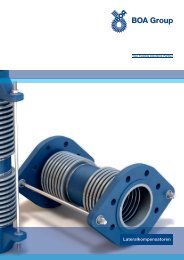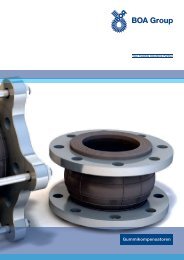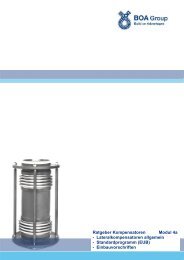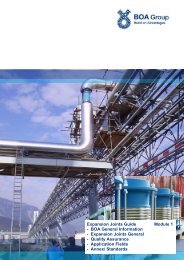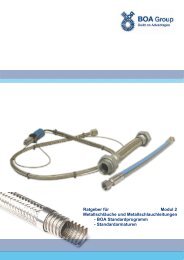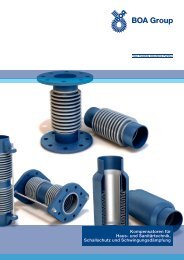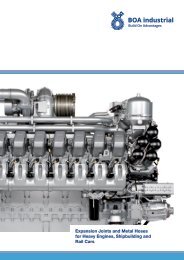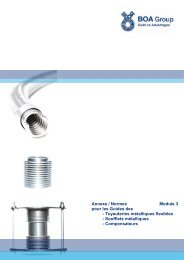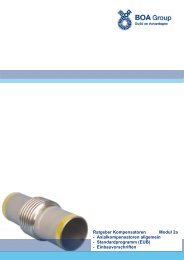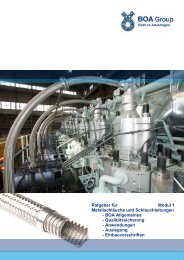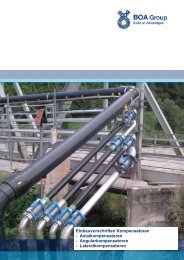Module 2a Axial Exp.Joints BOA AG General - BOA Group
Module 2a Axial Exp.Joints BOA AG General - BOA Group
Module 2a Axial Exp.Joints BOA AG General - BOA Group
Create successful ePaper yourself
Turn your PDF publications into a flip-book with our unique Google optimized e-Paper software.
<strong>BOA</strong><strong>Exp</strong>ansion <strong>Joints</strong> Guide2 Standard Program <strong>BOA</strong> <strong>Axial</strong> <strong>Exp</strong>ansion <strong>Joints</strong> (EFB)2.1 <strong>General</strong><strong>Exp</strong>ansion joints manufactured by <strong>BOA</strong> <strong>AG</strong> Switzerland are formed in the elastomer process (EFB). The core element is the multi-ply metalbellows (2 to 16 layers) made of austenitic steel. <strong>Exp</strong>ansion joints produced by this method have a large expansion capacity and are veryflexible. They are especially appropriate to compensate for thermal expansion and minor misalignment during installation. Their advantagesare: <strong>BOA</strong> <strong>AG</strong> has over 70 years experience in manufacturing expansion joints multi-ply construction of the bellows, made of high-grade stainless steel (1.4571 and 1.4541), which means high resistance againstageing, temperature, UV-rays and most of aggressive media. very low spring rate due to the multi-ply construction of the bellows. large movements at short construction lengths due to reasonable stocks, various types in different sizes and pressure ranges are usually available at short time.Inner sleeveInner sleeves protect the bellows and prevent it from being stimulated to oscillate by the fluid. The installation of an inner sleeve is recommendedin the following cases: abrasive media large temperature variations flow rates higher than approx. 8m/s for gaseous media flow rates higher than approx. 3m/s for liquid mediaWhen installing, the flow direction must be observed!The designation for the design with/without inner sleeve for axial expansion joints (Types W, FS, FB) is the following:<strong>Exp</strong>ansion joint types marked with* are available either with or without inner sleeve (extra charge for inner sleeve).<strong>Exp</strong>ansion joint types marked "B" do not need an inner sleeve because of their short length.<strong>Exp</strong>ansion joint types marked "L" have always an inner sleeve.Example:Type FS16-3BType FS16-3LType FS16-2*= Basic version without inner sleeve= Basic version with inner sleeve= Basic version without inner sleeve, but may be equipped with inner sleeve.2.2 Reduction2.2.1 <strong>Exp</strong>ansion capacityNOTE (Hereinafter the term load cycle is used for full load change cycle.)The maximum permissible expansion capacity is indicated on the expansion joint. It refers to 1000 load cycles (for expansion joints conformingto EC standards: 500 load cycles with safety factor 2). At higher load cycles, the expansion capacity must be reduced by the load cycle factorK L according to table 1. For the accurate determination of the load factor K L the following formula can be applied:K L = (1000 / N adm ) 0.29Load cyclesN adm1'0002'0003'0005'00010'00030'00050'000100'000200'0001'000'00025'000'000Load cycle factorK L1.000.820.730.630.510.370.320.260.220.140.05 Table 15



